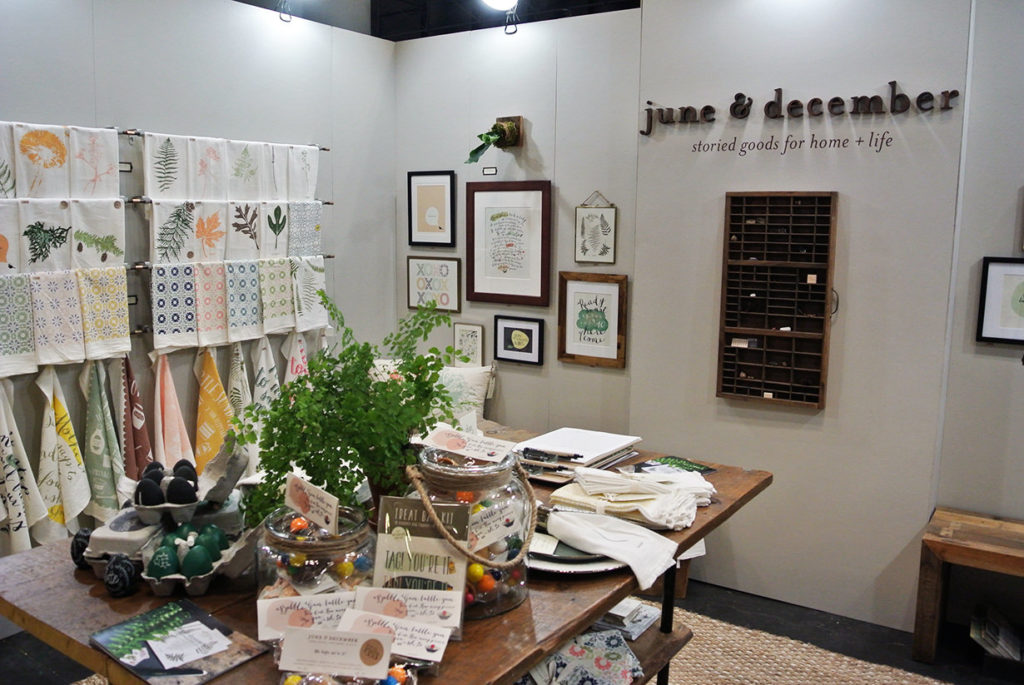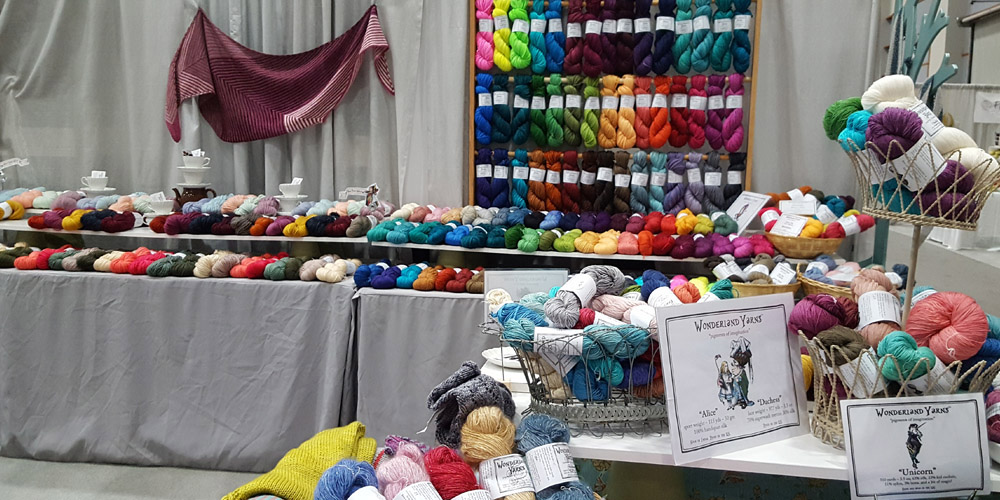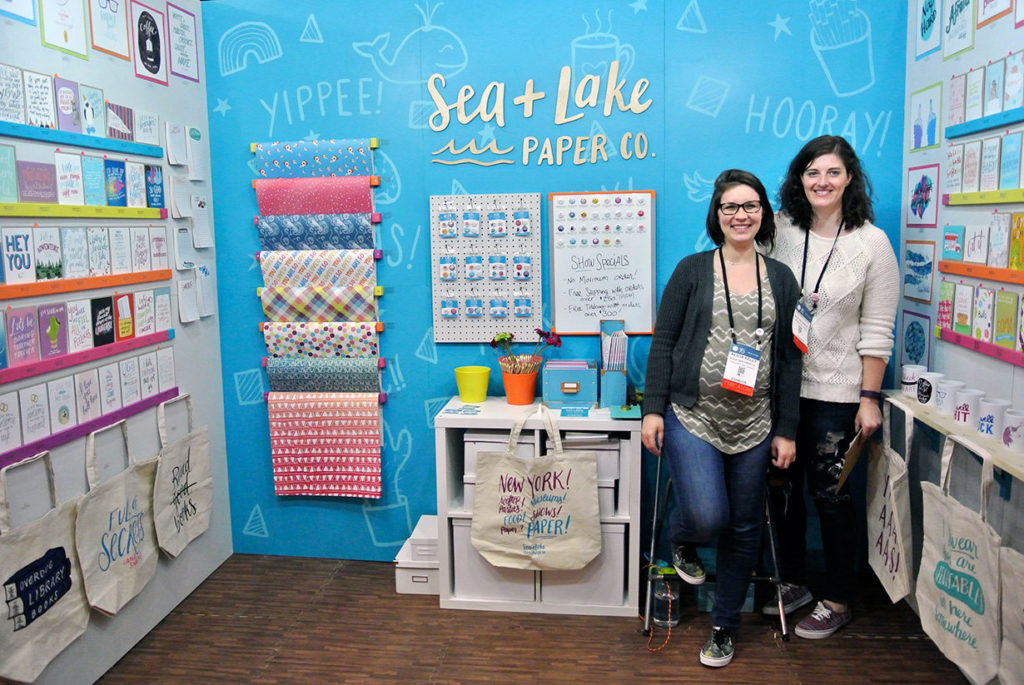
June & December booth.
Photo © Sam Hirst for Aeolidia
The National Needlework Association (TNNA) will hold its winter trade show primarily in hotel suites rather than a convention center. Dave Van Stralen, president of TNNA which is the trade show for the yarn industry, says the decision was necessary due to “declining vendor and store participation particularly from the yarn segment, the interest and need from some segments to reduce cost of vending, and reduced cost for TNNA and ultimately its membership.” As shop owners and consumers become increasingly able to learn about and purchase new products online, trade shows are feeling the squeeze.
TNNA is not the only trade show feeling the pressures of reduced attendance and the need to cut costs. Quilt Market, the trade show for the quilting industry, is as well. “More exhibitors are understandably debuting and releasing product information online—with ordering capabilities—prior to the show and year round,” explains Bob Ruggiero, director of publications and public information at Quilts, Inc., the company that produces Quilt Market.
“The shops are in turn statistically sending fewer employees to Market, often due to travel and lodging expenses. This has admittedly decreased the ‘buzz’ factor,” Ruggiero said.
Attending a trade show is a significant financial investment for retailers, and some feel it’s no longer as necessary to attend twice a year—or at all. At one time, as Ruggiero mentions, the release cycles for new products were timed to occur at the trade shows, but today products are released more frequently and buzz is generated online. Sales representatives visit shops frequently to show the new lines, and many manufacturers offer online ordering, making the travel costs hard to justify.

Wonderland Yarns booth
Photo by Stacey Trock
Six years ago, Michael Miller Fabrics, a leading manufacturer of quilting cottons, rented 16–18 booths at Quilt Market. Today, they’re taking significantly less. “The paring down has been a Market-to-Market kind of decline,” says the company’s co-founder Michael Steiner, “which really just simply reflects the slow decline in the number of customers that come to the show.”
Yet Miller emphasizes that attending a trade show is still important for businesses like his. “The face-to-face part shouldn’t be replaced by technology,” he says. “Quilt Market still plays an important part in our industry; it’s just that one of the parts it used to play—sales over a three-day period— is not as important of a part.”
For TNNA a suite-style show is the response to this changing landscape. The winter show has for many years focused on cross stitch and needlepoint, segments that prioritize keeping costs low and are accustomed to suite shows elsewhere.
In a suite show, each company sets up wares in their hotel suite with the door propped open, and attendees travel from suite to suite placing orders. The Nashville Needlework show is a suite show at which Susan Fitzgerald, owner of the cross-stitch business Red Gate Stitchery, exhibited this year. Although it’s less costly overall, Fitzgerald points out that a suite show can hamper discovery of new brands. “In a convention center, you have the opportunity to catch someone’s eye,” she says. “If you’re an unknown [at a suite show] people have to take that initiative and get over that barrier to enter your room and see what you have.”

Christina and Alicia of Sea & Lake Paper Co.
Photo © Sam Hirst for Aeolidia
Yet discovery is one of the few aspects of a trade show that many attendees say they value most. “The thing about coming to the show is the serendipity of who you meet and what you see while you’re there,” says Kathy Miller, co-founder with Steiner of Michael Miller Fabrics. For show organizers, promoting discovery of new brands may be a way to convince retailers it’s still worthwhile to attend. Organizers can even cultivate new talent by subsidizing booth costs and giving new companies premium spots on the show floor to ensure that discovery opportunities exist.
According to trade show and event consultant Tony Lee, it’s time for an overall mindset shift about the purpose of trade shows. Lee advises companies to start by rethinking how they calculate their return on investment. Forging new relationships and strengthening existing ones should be part of that calculations as should orders that come in weeks, even months, later.
Brands need to update their trade show strategy as well in order to make the most of their exhibiting dollars. One way to do this is to leverage the online engagement they’ve been building all year by making the trade show an exciting culmination for consumers following along on social media.
Former vice president of the National Stationary Show for 24 years, Patti Stracher explains, “Social media has really changed the potential of a show. It creates a mushroom of community building and can have a powerful effect.” Steiner agrees, asserting that for his company the trade show “has definitely evolved into a marketing purpose.”
Creating a special hashtag and display that beckons people to take photos and share online can generate consumer excitement at home. Lee says these shares, and the engagement levels they generate, should be considered part of the success metric for the show as well. Brands can further build excitement by orchestrating surprises that unfold as the show progresses.

Stitch Sprouts booth.
Photo by Stacey Trock
Networking continues to be a strong driver for exhibitors and attendees of trade shows. Show organizers can strengthen the available networking experiences in order to add value to the show and make it worthwhile for attendees. According to Stracher this kind of preparation is critical. “Spontaneous networking is not effective,” she says. Instead, shows should encourage pre-show product screenings, tours, artist signings, and niche parties.
Show organizers can also facilitate matchmaking between brands and influencers at the event. The Baby Lock Common Threads gathering is a business-to-business annual event for brand ambassadors, designers, teachers, and influencers affiliated with the Baby Lock sewing machine company. Attendees participate in a “speed dating”-style networking activity in which they have a few minutes to introduce themselves to each other and make new connections. “That is a good way to meet people you might not otherwise have a conversation with within the group,” says pattern designer Melissa Mora, who has attended the event for a few years. “The contacts I have met at Common Threads have led to some of my most valuable professional relationships.”
As trade shows become less about order writing and more about discovery and networking, the lines between a conference, retreat, trade show, and workshop may blend. All are in-person events that give people the opportunity to meet one another face to face, learn from each other, and begin to work together. They’re also a place to be thrilled and entertained. Certainly trade shows are still set apart because they focus on order writing, but if that activity continues to wane will that be enough to keep them vital?
“The online world is here for good, and will only increase in prevalence and relevancy,” Ruggiero points out. “The challenge for us, or producers of any trade show in any industry, is to keep pace with those developments while also creating an atmosphere in which the ‘in-person’ and ‘online’ experiences both work together.”

What a great article, and something I’ve been thinking about a lot recently. I began attending TNNA 8 years ago, and as a new and independent designer, it was a great expense. But I got *so* much out of it by talking with companies and other professionals. Every single time, I’ve made my money back by the opportunities I’ve gotten that I’m convinced are (at least for the next decade) cemented by face-to-face interaction.
I completely agree with this comment 100%
Great article Abby,
Almost all my clients have an opinion about TNNA moving to the suite style exhibition and I’d characterize the mood as “optimistic yet skeptical” I guess time will tell as to whether that will be a successful formula. I do worry about the networking limitations so I hope organizers will consider some of the ideas out there to bring together the exhibitors with people that don’t go only to buy like designers, biz services, publishers, influencers and so on. I love the speed-dating idea.